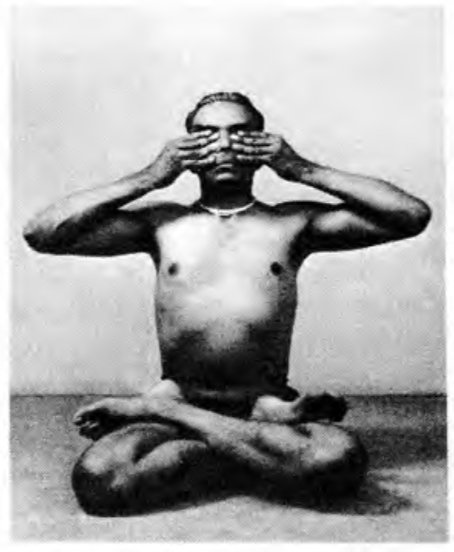Search your article
Sanmukhi Mudra
Sanmukhi Mudra – 4
San means six and mukha means the mouth. Sanmukha is the name of the six-headed god of war, also known as Kartikeya. Mudra means a seal or closing up.
The posture is also called Parangmukhi’ Mudra (facing inwards), Sambhavi’ Mudra (Sambhu is the name of Siva, father of Kartikeya. Hence, Sambhava is the progeny of Siva), also as Yoni Mudra. Yoni means the womb, the source. The mudra is so called because the aspirant looks within himself to find the very source of his being.
Technique
1. Sit in Padmasana. Keep the spine erect and the head level.
2. Raise the hands to the face. Lift the elbows to the level of the shoulders, place the thumbs on the ear-holes so as to cut off external sounds. If the thumbs in the ear-hole cause pain, push the tragus (the small prominence at the entrance of the external ear) over the ear holes and press it with the thumbs.
3· Close the eyelids, but turn the eyes up. Place the index and middle fingers on the closed lids so that the first two phalanges only press the entire eyeball. Do not, however, press the cornea. Pull the eye lids down with the middle finger. Push the upper part of the eyelids below the eyebrow upwards with the index fingers. Gently press the eyes at both the corners.
4· Equal pressure should be maintained on the ears and the eyes.
5· With the tips of the ring fingers press both nostrils equally. The nasal passages are thus narrowed for slow, deep, steady, rhythmic and subtle breathing.
6. The little fingers are placed on the upper lip where they can check the rhythmic flow of the breath.
7· Stay in this position as long as you can, drawing the vision inwards.
Effects
The senses are turned inwards and the rhythmic breathing calms the mind’s wandering. This brings a feeling of inner peace and one hears the divine voice of his self within, ‘Look here ! look within! not out side, for the source of all peace is within yourself.’ The posture thus prepares the practitioner for the fifth stage of yoga, Pratyahara, where he attempts to free himself from the thraldom of the senses and to prevent them from running after their desires.
